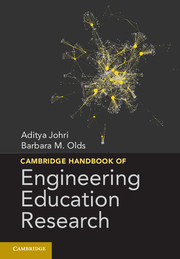Book contents
- Frontmatter
- Dedication
- Contents
- Editors
- Contributors
- Foreword
- Acknowledgments
- Introduction
- Chapter 1 Chronological and Ontological Development of Engineering Education as a Field of Scientific Inquiry
- Part 1 Engineering Thinking and Knowing
- Part 2 Engineering Learning Mechanisms and Approaches
- Part 3 Pathways into Diversity and Inclusiveness
- Part 4 Engineering Education and Institutional Practices
- Part 5 Research Methods and Assessment
- Chapter 24 Studying Teaching and Learning in Undergraduate Engineering Programs
- Chapter 25 Design-Based Research in Engineering Education
- Chapter 26 Quantitative and Mixed Methods Research
- Chapter 27 Framing Qualitative Methods in Engineering Education Research
- Chapter 28 Conducting Interpretive Research in Engineering Education Using Qualitative and Ethnographic Methods
- Chapter 29 The Science and Design of Assessment in Engineering Education
- Part 6 Cross-Cutting Issues and Perspectives
- Index
- References
Chapter 25 - Design-Based Research in Engineering Education
Current State and Next Steps
Published online by Cambridge University Press: 05 February 2015
- Frontmatter
- Dedication
- Contents
- Editors
- Contributors
- Foreword
- Acknowledgments
- Introduction
- Chapter 1 Chronological and Ontological Development of Engineering Education as a Field of Scientific Inquiry
- Part 1 Engineering Thinking and Knowing
- Part 2 Engineering Learning Mechanisms and Approaches
- Part 3 Pathways into Diversity and Inclusiveness
- Part 4 Engineering Education and Institutional Practices
- Part 5 Research Methods and Assessment
- Chapter 24 Studying Teaching and Learning in Undergraduate Engineering Programs
- Chapter 25 Design-Based Research in Engineering Education
- Chapter 26 Quantitative and Mixed Methods Research
- Chapter 27 Framing Qualitative Methods in Engineering Education Research
- Chapter 28 Conducting Interpretive Research in Engineering Education Using Qualitative and Ethnographic Methods
- Chapter 29 The Science and Design of Assessment in Engineering Education
- Part 6 Cross-Cutting Issues and Perspectives
- Index
- References
Summary
Introduction
Engineering education research is looking to research methods in education and related social sciences as a source for new approaches (Adams et al., 2011; Borrego & Bernhard, 2011; Case & Light, 2011; Davison, 2010; Ganesh, 2011; Johri & Olds, 2011; Pears, Fincher, Adams, & Daniels, 2008; Streveler & Smith, 2010). Design-based research in education, the focus of this chapter, is a natural source for ideas because this emerging methodology draws on engineering practices for some of its key values and approaches (e.g., Brown, 1992; Hjalmarson & Lesh, 2008; Middleton, Gorard, Taylor, & Bannan-Ritland, 2008). Indeed, inspiration for one of the early stage models for design-based research in education (Bannan-Ritland, 2003) was proposed by Woodie Flowers, an MIT engineer, at a National Science Foundation (NSF)–funded workshop (Kelly & Lesh, 2001). Design-based research can contribute to engineering education research because it also draws on (1) a tradition of studies in mathematics and science education (e.g., Cobb, McClain, & Gravemeijer, 2003; Kelly, Baek, Lesh, & Bannon-Ritland, 2008) and (2) frameworks from diffusion of innovations (Zaritsky et al., 2003) and more recently (3) from educational data mining (e.g., Baker & Yacef, 2009).
In this chapter, I use one model for design-based research in education, the Integrative Learning Design (ILD) framework (Bannan-Ritland, 2003), and illuminate its use with examples from education and an engineering education study by Hundhausen, Agarwal, Zollars, and Carter (2011). I suggest next steps in design-based research for engineering education research, including the creation of a Design Exchange for Scholars that would actively integrate insights from educational and engineering education research and place a greater emphasis on learning analytics and educational data mining.
- Type
- Chapter
- Information
- Cambridge Handbook of Engineering Education Research , pp. 497 - 518Publisher: Cambridge University PressPrint publication year: 2014
References
- 18
- Cited by

